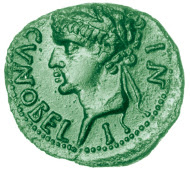A few coins and artefacts from the period of Cymbeline or Cunobelini
for more information see:- https://en.wikipedia.org/wiki/Cunobeline
gold coin of Cunobelini
bronze coin of Cunobelini at Camulodenum
Atrebates Chichester boar, silver coin
bronze coin of Cunobelini at Camulodenum now Colchester in Essex
Gold coin of Caractacus son of Cunobelini
Silver coin of Caractacus
gold coin of Cunobelini at Camulodenum
Bronze coin of Addedomarus
Addedomarus appears in later, post-Roman and medieval British Celtic genealogies and legends as Aedd Mawr (Addedo the Great). The Welsh Triads recall Aedd Mawr as one of the founders of Britain.
Silver coin of Caractacus
Silver coin of Verica
Verica (early 1st century AD) was a British client
king of the Roman Empire in the years preceding the Claudian invasion of 43 AD. From his coinage, he appears to have been
king of the Atrebates tribe and a son of Commius. He succeeded his elder
brother Eppillus as king in about 15 AD, reigning at Calleva Atrebatum, today
called Silchester. He was recognised as rex by Rome and appears to have
had friendly trade and diplomatic links with the empire. His territory was pressed from the east by
the Catuvellauni, led by Epaticcus, brother of Cunobelinus, who conquered
Calleva in about 25 AD. After Epaticcus's death ca. 35 AD Verica regained some
territory, but Cunobelinus's son Caratacus took over and conquered the entire
kingdom some time after 40 AD. Dio
Cassius records that "Bericus" (almost certainly Verica) was expelled
from Britain around this time during a revolt. Suetonius refers to
demands by the Britons that Rome return "certain deserters". As rex, Verica was nominally an ally of
Rome, so his exile gave Claudius an excuse to begin his invasion. Verica's relationship with Rome has been used
to argue for the site of the Roman invasion of Britain as being along the south
coast to assist him, rather than being at the traditional spot at Richborough
in Kent. After the invasion, Verica may have been restored as king, but this is
not attested in the historical or archaeological record. In any case a new
ruler for the region, Cogidubnus, soon appeared. Cogidubnus may have been an
heir of Verica who by this time would have been very elderly indeed.
above and below head & tail of bronze coin of Cunobelini at Camulodenum
Bronze mask of Cunobelini as the Sun-God Bel
gold coin of Cunobelinus
gold coin of Cunobelinus of Camulodenum
Silver coin of Cunobelinus
Gold coin of Cunobelinus
bronze coin of Cunobelinus
bronze coin of Cunobelinus
bronze coin of Cunobelinus
bronze coin of Cunobelinus
Gold coin of Cunobelini
Bronze coin of Cunobelini
Map of Southern tribes of Britain
Bronze coin of Epaticcus circa 20 BC
Gold coin of Epaticcus circa 20 BC
Gold coin of the Atrebates
Gold stater of Cunobelini
lamp found with coins of Cunobelini
Iron-age central Europe
Vercingetorix denarius-hostilius.
Vercingetorix was a chieftain of the Arverni tribe; (see map) he united the Gauls in
a revolt against Roman forces during the last phase of Julius Caesar's Gallic Wars.
William Blake's visionary depiction of Caractacus, son of Cunobelini


































I suspect the Norfolk goddess of war was the origin of the children's dipping-out chant "Eoni, meany, miney, mo, catch a member of a swarthy ethnic minority by his toe, if he hollers let him go, Eoni, Meoni, Miney, Mo!"
ReplyDeleteI hope you will not consider me a niggard for withholding the original word for he who was to be caught by a pedal phalange.
Hello Crowbard. I've just put up an illustration of an ancient British coin on today's blog entry, which you might find of interest.
ReplyDelete